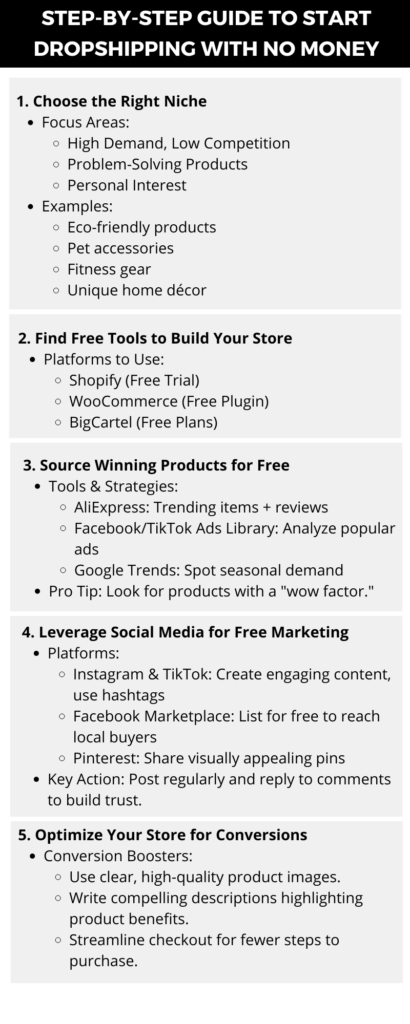Starting a dropshipping business is like standing at the ocean’s edge. You stare into the unknown. Many aspiring entrepreneurs find eCommerce scary. It needs a big upfront investment. But what if I told you that it’s entirely possible to embark on this journey with little to no money? This guide will show you how to start dropshipping on a budget. It will provide you with practical tips and a clear plan.
What Is Dropshipping?
Imagine a world where you can sell products without ever having to touch them. That’s the magic of dropshipping. In this eCommerce model, you set up an online store and showcase products. When customers place orders on your site, your supplier ships the product directly to them. You pay for products only after making a sale. This eliminates high upfront costs and the need to store inventory.
Why Start Dropshipping with No Money?
For those on a tight budget, dropshipping is an ideal entry point into the world of online business. Here’s why:
-
No Inventory Costs: Forget about warehouses or storage fees; you don’t need them.
-
Low risk: You buy products only after securing sales. This minimizes your financial risk.
-
Accessible Tools: Many platforms allow you to start for free or with minimal investment.
-
Scalable Model: Begin small and grow as your profits increase.
Step-by-Step Guide to Start Dropshipping with No Money
1. Choose the Right Niche
To succeed in dropshipping, start by picking a profitable niche. Picture yourself exploring various product categories. Focus on:
-
High Demand, Low Competition: Seek products that are popular but not oversaturated in the market.
-
Problem Solvers: Items that address specific customer needs or issues.
-
Personal Interest: Choose niches that excite you. Passion fuels motivation.
Example Niches: Eco-friendly products, pet accessories, fitness gear, or unique home décor are good. They are good starting points. This article, “11 Winning Dropshipping Niches in 2024,” explores 11 profitable niches. They have high potential in 2024. It shows market trends and consumer demands.
2. Find Free Tools to Build Your Store
You don’t need fancy tools to get started. Consider these options:
-
Shopify (Free Trial): It has easy templates, perfect for beginners.
-
WooCommerce: A free WordPress plugin for eCommerce.
-
BigCartel: Ideal for those just starting out with free plans available.
By leveraging these platforms, you can build your online store without upfront costs.
Pro Tip: This article, “7 E-Commerce Tutorial Tips for Shopify Beginners,” has seven tips for beginners in e-commerce using Shopify. They will boost their online stores’ performance and user experience.
3. Source Winning Products for Free
Finding winning products doesn’t require expensive tools. Use these free strategies:
-
AliExpress: Look for trending items and check reviews to gauge their popularity.
-
Facebook and TikTok Ads Library: Analyze successful ads to spot popular products.
-
Google Trends: Spot seasonal or rising demand in product categories.
Pro Tip: Targeting the right geographic markets is vital to your dropshipping success. This article ranks the best countries for dropshipping – 7 Best Countries for Google Ads Dropshipping (Free Checklist). It considers factors like market potential and ease of entry.
4. Leverage Social Media for Free Marketing
Without a marketing budget, social media becomes your best friend. Here’s how to get started:
-
Instagram and TikTok: Make engaging content. Share Reels. Use trending hashtags to reach a wider audience.
-
Facebook Marketplace: List your products for free to reach local buyers.
-
Pinterest: Share visually appealing pins that drive traffic back to your store.
Pro Tip: Post regularly and reply to comments to engage your audience. Over time, you’ll build a loyal following.
5. Optimize Your Store for Conversions
Attracting visitors is just the beginning; turning them into buyers is key. Follow these tips:
-
Use clear, appealing images to showcase your products. They should draw in customers.
-
Compelling Descriptions: In your product descriptions, show their unique features and benefits. This will entice buyers.
-
Optimize Checkout: Make it easy for customers to buy with few steps.


